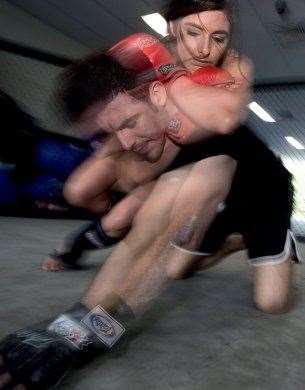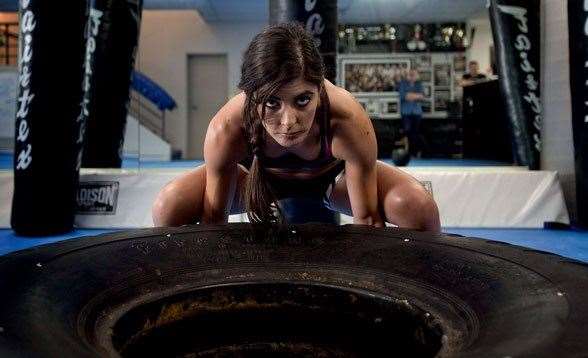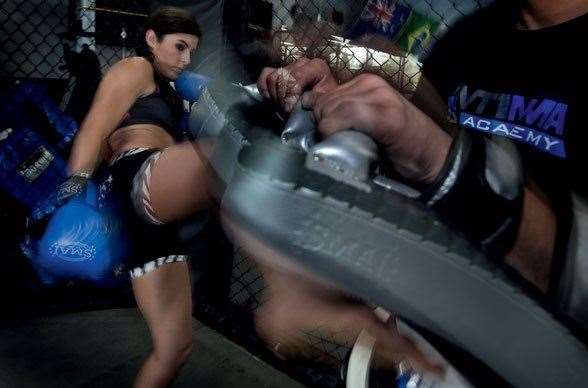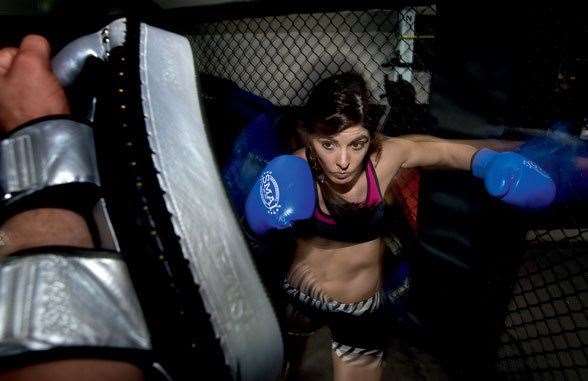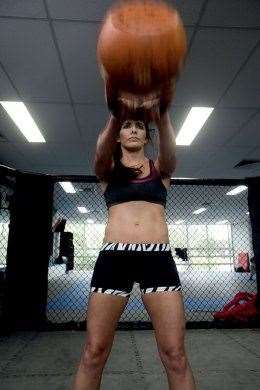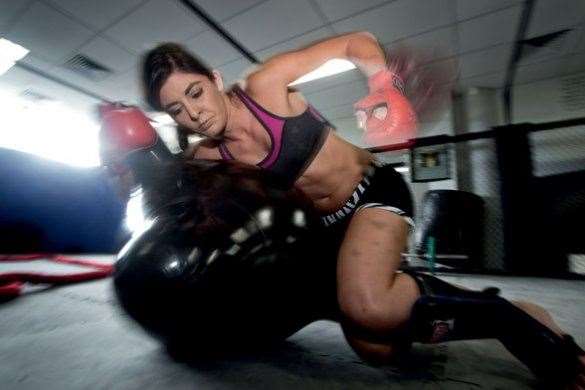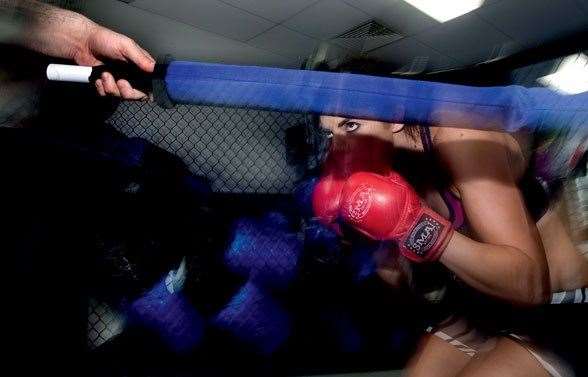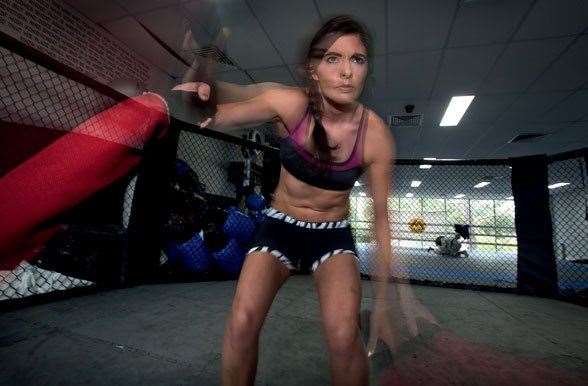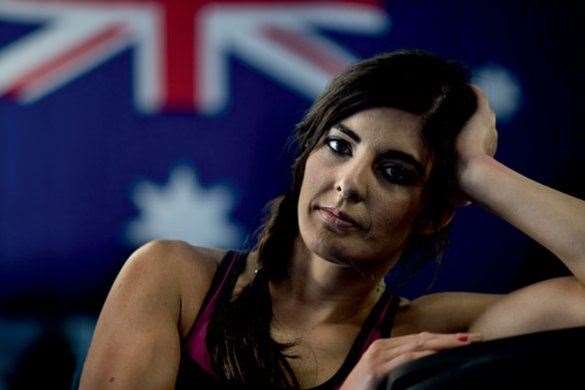The all-female "The Ultimate Fighter" field will underestimate “Astro Girl” at their peril.
Women’s mixed martial arts is rattling the cage. In 2013 we saw the first-ever UFC pay-per-view event headlined by a women’s fight, as well as female contestants debuting on the hit reality television show The Ultimate Fighter. Perhaps, though, in the ultimate sign of respect for how quickly the women’s side of the sport has rocketed up the popularity charts, in 2014 the ladies have the big stage all to themselves. Back in May, a host of elite competitors reported to Las Vegas and participated in season 20 of the show in the first-ever all-women’s version of The Ultimate Fighter. And in another “first time ever”, TUF will crown a UFC champion, with the winner becoming the inaugural UFC women’s strawweight title-holder, a newly created fighting weight.
Two of these Vegas-visiting fighters were Aussies – Bec Rawlings and Alex Chambers, the latter a pocket dynamo from Manly, NSW, who was chomping at the bit to mix it with her full house of opponents. “Astro Girl” wasn’t just out to appear on the silver screen and make up the numbers, mind you. Before TUF she’d already boasted an impressive 4-1 career record which included two TKO wins. At 160cm and a natural fighting weight of 47kg, her opponents’ biggest mistake would’ve been to underestimate her on size alone. Here’s how Chambers prepared for being the biggest little underdog on TUF, which will air in Australia direct from the US this month on the FX channel.
GIRLS’ GAME
“In the past I haven’t told too many people about what I do; I’ve been fairly private about it. But these days I guess I do find myself sharing my career with more and more strangers. Females fighting in MMA is definitely becoming a little bit more accepted in the wider community, especially with high-profile fighters like Ronda Rousey doing really good things for MMA, and female promotions in America like Invicta FC putting women out there in the martial arts world. Public perception isn’t going backwards, it’s moving forwards. The UFC introducing its new 115-pound [52kg] strawweight division is something I’m really proud of.”
BACK IN THE DAY
“I’d competed in karate since I was really young. My uncle got me and my cousins into it because he thought self-defence and building confidence in us as kids was important. I competed in karate competitions, even internationally, and during my time in the sport I’d learnt a few moves on the ground – things like arm bars – in seminars; moves which you don’t perform in karate. I picked up other little one-off pieces of knowledge along the way as well. I always enjoyed that part of it. That’s what got me interested in MMA. I had that background in karate and it was just a natural process in challenging myself further and wanting to learn new things. I’d watched a little bit of MMA and I really wanted to learn the grappling side of things. I love martial arts and I love learning, so I Googled ‘MMA gyms’ and I found VT-1 at Chatswood in Sydney and I’ve been with them ever since.”
ULTIMATE PLAN
“I train two-three times a day; a morning session and an afternoon/evening session, six days a week. It’s so important to have a rest day and allow my body and mind to recover from a tough week, or I’ll burn out too quickly. My sessions typically last 60-to-90 minutes, with a proper warm-up prior to the start of the session to activate muscles and properly prepare them to lessen the risk of injury. I have a cool-down and a stretch after the session to help with muscle recovery as well. Generally my sessions fall under a handful of categories: striking (Muay Thai/boxing), wrestling/clinch, and ground work. Then we put these various skills together in MMA-fighting-based sessions, or strength and conditioning [weights and conditioning circuits] or sparring. Some sessions are spent on refining skills and others on putting these skills into practice in live sparring with a partner. If I do an intense drilling session in the morning [drills involve repetition of certain skills in practice against a partner providing increasing resistance], then the afternoon/evening session is more skill-based, focusing more on refining technique and fight strategy rather than a physically demanding session. If I have a sparring session planned in the afternoon/evening, then the morning session intensity is decreased, focusing more on refining techniques and strategy.”
KICKIN THE HABIT
“Setting up the perfect kick so your opponent doesn’t see it coming is vital in MMA. If they do see it, they can catch you and take you down off it. Distancing and timing is crucial; setting it up properly with other strikes, for example hiding behind a strike. The power generated in a kick comes from your technique, and also speed. Most people think if they try really hard, they’re going to get a lot of power out of their kick, but actually the opposite is true. Being able to relax into your kick, having the right technique and adding some speed, that’s how you get your power. It’s the same for your upper-body strikes.”
PADDING UP
“In a session with my striking coach Dylan Resnekov, we’ll keep the take-downs out of it; I put that stuff together in my MMA session. In strike training we focus on various combinations, specific responses, a lot of strategy, sharpness, distancing from your opponent, footwork ... fine-tuning the skills I already have. The strike session lasts about an hour or so, but the whole hour isn’t focussed on pads. We might do some partner work, putting it together with the coach on the pads as well.”
KETTLE’S ON
“Sometimes I incorporate kettlebell swings into my strength and conditioning circuit to build my anaerobic capacity. It’s a hip-dominant exercise. It looks like it’s for your arms, but it’s to build power in your legs and hips, which is important in MMA – using your hips really well, not just for striking, but for hitting while you’re on the ground, too. The rope, meanwhile, is a great full-body exercise. It’s good for improving grip and gets the heart-rate up a bit. The tyre work is part of a strength and conditioning session as well. The exercise itself isn’t a skill we need; obviously we’re not flipping tractor tyres in the cage, but it’s a full-body exercise that requires immense power. A lot of muscles are getting used while flipping the tyre.”
GROUND AND POUND
“We do a lot of drilling, which involves common fight scenarios. First we focus on technique, then we put it into practice in drilling situations. If we’re working a particular part of the ground game and we’ve learnt a technique, we’ll put it into practice against some form of resistance and slowly build that resistance with a partner, who for this photo shoot was my head coach Liam Resnekov. I definitely like the ground and pound part of the ground game in MMA; hitting people in the face, I guess, on the ground. I’m a purple belt in Brazilian jiu jitsu, so I’ve been trained in the ground game throughout my career. I guess I like playing top position on the ground a lot, whereas a lot of women become comfortable, say, on their back for a closed guard. I’m confident when in a position on the ground where I feel I can finish my opponent off.”
COPPING STICK
“It might look a bit weird, but sometimes my trainer hits me with two long, padded blue sticks. It’s a versatile training aid. The sticks are ideal for getting my distancing and timing right as far as striking and moving my head are concerned. It’s great for slipping punches, weaving underneath and accuracy. It’s good for developing cover-respond skills and check-respond speed and sometimes flow and balance-type awareness as well. You can use the sticks a lot of different ways.”
WHAT TO EAT
“I wouldn’t say I’m overly strict on myself when it comes to my diet. I kind’ve walk around at my fight weight; I don’t need to lose weight, if anything I need to put it on. That’s probably one of the difficult things about training two-three times a day, trying to eat enough to maintain weight. I get told by experts to eat, eat, eat and eat some more. I get all my vitamins and minerals from vegetables. I like to eat a lot of pasta, too. Sometimes I might treat myself to ice cream and chocolate. As a female athlete, with the demands of training, low iron levels can be a problem, so I take a multi-vitamin and iron supplement to get me through. I’m lucky to be sponsored by the Aussie protein company F1 Nutrition. They provide me with all the protein products I need, as well as others like glutamine and BCCAs [branch chain amino acids], which help with recovery.”
ULTIMATE FIGHTER
“I’m really excited about appearing in the next The Ultimate Fighter series, and about the fact the UFC is involving more women and including the new strawweight division. I knew it wasn’t going to be easy having to fight girls who you’re living in the same house with. There aren’t too many women involved in the sport in Australia, so you don’t usually get that chance to train with people your own weight. I didn’t just go there to make up the numbers; I went there to shock the world, that’s for sure. Definitely being mentally strong helps you in there. It’s a big mental game, fighting. As some people have said, it’s 80 per cent mental and 20 per cent physical. I was one of the underdogs, fighting a little lighter and being a little older than most. My speed is probably my greatest strength; I have to be fast because I’m usually a lot smaller than the people I fight. That’s what I focussed on going into the house, because I knew a lot of the girls were going to be a bit bigger than me. I felt that I had to be faster than them.”
Related Articles

Alex Chambers ready for The Ultimate Fighter 20
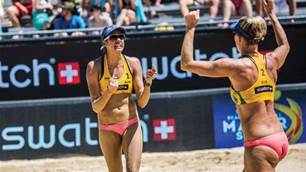
How Australia's beach volleyball women train


